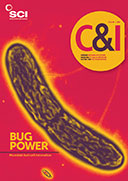A type of caterpillar called a wax worm can break down polyethylene (PE), which is notoriously difficult to degrade, according to Spanish researchers. And not only does the worm degrade the plastic, it converts it into ethylene glycol.
Federica Bertocchini of the Institute of Biomedicine and Biotechnology of Cantabria in Spain and her colleagues made the discovery by accident. They noticed that plastic bags containing wax worms quickly became riddled with holes. Further study showed the worms - larvae of the wax moth - can damage a plastic bag in less than an hour.
PE comprises a linear backbone of carbon atoms, which is resistant to degradation. Some researchers have reported degrading PE using bacteria but this can take several weeks. The worms, however, work much faster.
When a PE film was left in direct contact with wax worms, holes started to appear after 40 minutes, reports the team, which also involved researchers from the University of Cambridge. Around 100 wax worms can reduce the mass of typical PE shopping bag by 92mg in about 12 hours. The average degradation rate is ‘markedly higher’ than the rate of biodegradation using microbes (Current Biology, 3 April 2017, 27, R1–R3).
Using FTIR analysis, the team discovered that the worms transform PE to ethylene glycol, confirmed by high performance liquid chromatography coupled with mass spectrometry.
So how can the wax worm degrade a chemical bond not generally susceptible to bio-degradation? It could be an extension of their natural habits, Bertocchini speculates. The moth lays its eggs inside beehives, where the worms grow to their pupa stage eating beeswax, a highly diverse mixture of lipid compounds, including alkanes, alkenes, fatty acids and esters.
‘Wax is a polymer, a sort of ‘natural plastic’, and has a chemical structure not dissimilar to polyethylene,’ Bertocchini says. The most frequent hydrocarbon bond is the CH2–CH2, as in PE. The researchers suggest that one of the worm’s targets of digestion is the C–C single bond of these aliphatic compounds.
The researchers would like to investigate whether this hydrocarbon-digesting activity derives from the organism itself, or from enzymatic activities of its intestinal flora; and also whether other related species have the same capacity for PE degradation.
As the molecular details of the process become known, the researchers say it could be used to devise a biotechnological solution to managing PE waste. ‘We are planning to implement this finding into a viable way to get rid of plastic waste, working towards a solution to save our oceans, rivers, and all the environment from the unavoidable consequences of plastic accumulation,’ Bertocchini says.
This is another exciting paper on insect larvae degrading plastics, says Jun Yang of Beihang University, Beijing.





